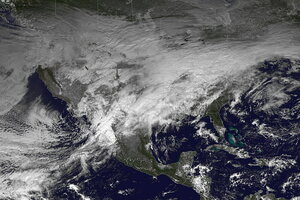How is global warming affecting precipitation? New satellite to help explain.
Set to launch in February, the Global Precipitation Measurement (GPM) satellite will, among other things, gather data that can help with efforts to monitor the effects of global warming on precipitation.

A NASA satellite captured this image of a storm system moving across the United States, Dec. 20. A new satellite, set to launch in February, will gather data that can help with efforts to monitor the effects of global warming on precipitation.
NASA/Reuters
The United States and Japan are getting set to launch a 4.3-ton satellite designed to monitor rain and snowfall in unprecedented detail.
The agencies announced on Thursday that they have scheduled the launch for Feb. 28, 2014, from Japan's Tanegashima Space Center on an island off the southern tip of the larger island of Kyushu.
The spacecraft, the Global Precipitation Measurement (GPM) satellite, has been designed as the centerpiece of an international squadron of nine satellites that are already on orbit.
The data the new satellite will gather not only will feed unique information into current efforts to forecast weather and monitor the effects of global warming on precipitation. GPM data also will serve as a standard against which data from the other satellites in the constellation will be adjusted to improve their accuracy.
Beyond weather and climate applications, data from the constellation will improve flood and landslide forecasts, as well as help track changes in the distribution of waterborne diseases, notes Ramesh Kakar, program scientist for this mission and its predecessor, the US-Japanese Tropical Rainfall Measuring Mission (TRMM) satellite, which was launched in 1997.
As the name implies, the TRMM satellite focuses on precipitation in the tropics – peering into the structure and rainfall patterns of storms ranging from afternoon thundershowers to large tropical cyclones. But it covered only the tropics and subtropics, and moderate to heavy precipitation intensities.
GPM and its sister craft, however, aim to extend those measurements to the rest of world and over a wider range of storm intensities. Of particular interest are storms over mid-latitudes, which can deliver precipitation at intensities ranging from gentle to torrential and with a variety of raindrop and snowflake sizes and shapes.
Adding this information will give climate researchers a more inclusive measure of the global water cycle than they have now, Dr. Kakar explains – a change that could help improve the way climate models represent the water cycle.
The satellite is equipped with two instruments: A high-resolution microwave radiometer, built by the National Aeronautics and Space Administration, will provide estimates of the overall intensity of rain and snow falling from particular storms, and a dual-frequency radar from Japan can build a 3-D picture of the distribution of rainfall and its intensity within a storm. In addition, the radar can capture data on the sizes and shapes of raindrops and snowflakes that a storm generates.
The two instruments also will yield estimates of the amount of heat that storms release as they form rain and snow, and how that energy is distributed within a storm. This heat is known as the latent heat of condensation. In essence, as droplets condense from water vapor as the vapor rises in a storm and cools, the droplets are releasing the heat it took to create the water vapor in the first place.
The released heat can further intensify storms. Its cumulative effect globally plays an important role in redistributing energy in the atmosphere.
The craft is designed to send updated information to the ground every three hours. In addition, its orbit some 250 miles above Earth is designed to cross those of other satellites in the constellation, with opportunities for simultaneous measurements that will allow the GPM satellite to serve as the benchmark for data from the other satellites.
NASA also provided the spacecraft's "bus," which houses navigation, communications, and power hardware in addition to serving as a platform for the instruments. Japan provided the radar and the rocket, an H-IIA, that will launch the satellite. NASA's portion of the tab for the mission is $913 million, says Candace Carlisle, deputy project manager for the mission at NASA's Goddard Space Flight Center in Greenbelt, Md.
Japan hasn't published hard numbers for its contribution, but the radar and rocket don't come cheap, Ms. Carlisle explains.
NASA shipped the satellite to Japan at the end of November after extensive tests at Goddard, "and the first month of testing at the launch site went extremely well," she says. "From the engineering side, we're very pleased" about the announced launch date, "and we're on target to meet it."
[Editor's note: The original version of this story did not correctly identify what GPM stands for.]

